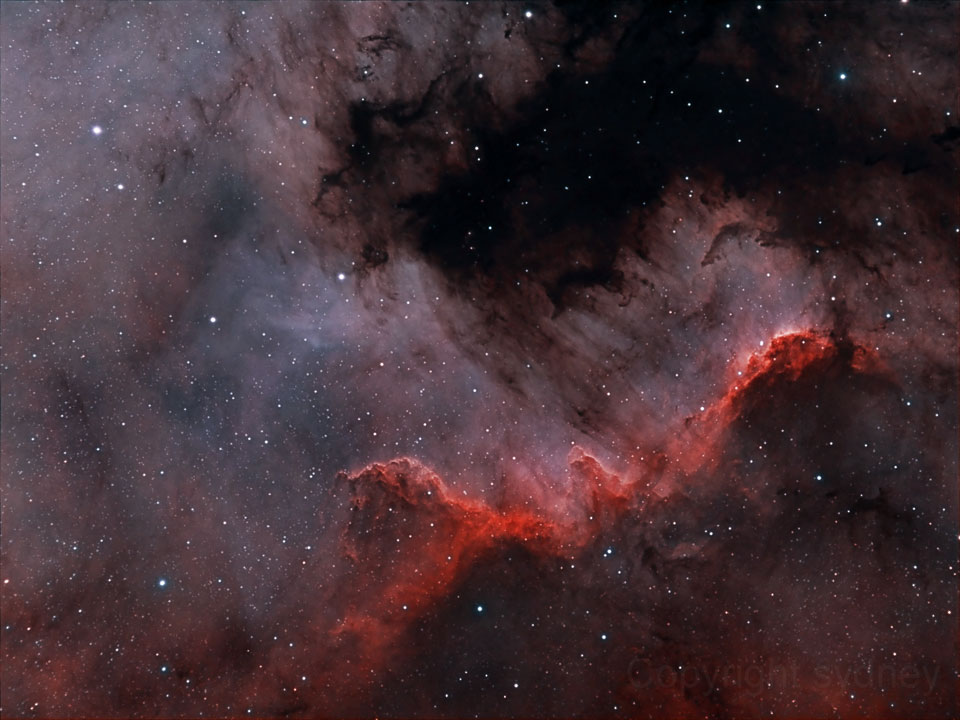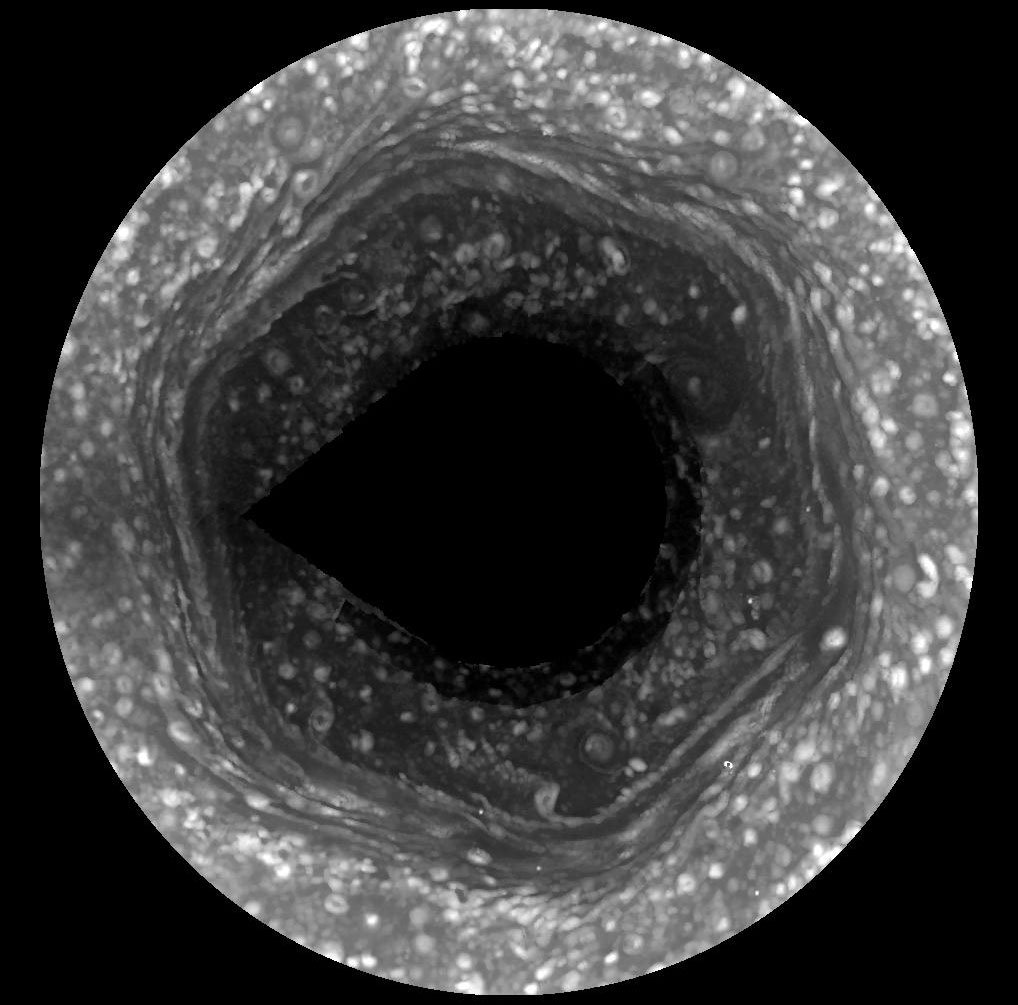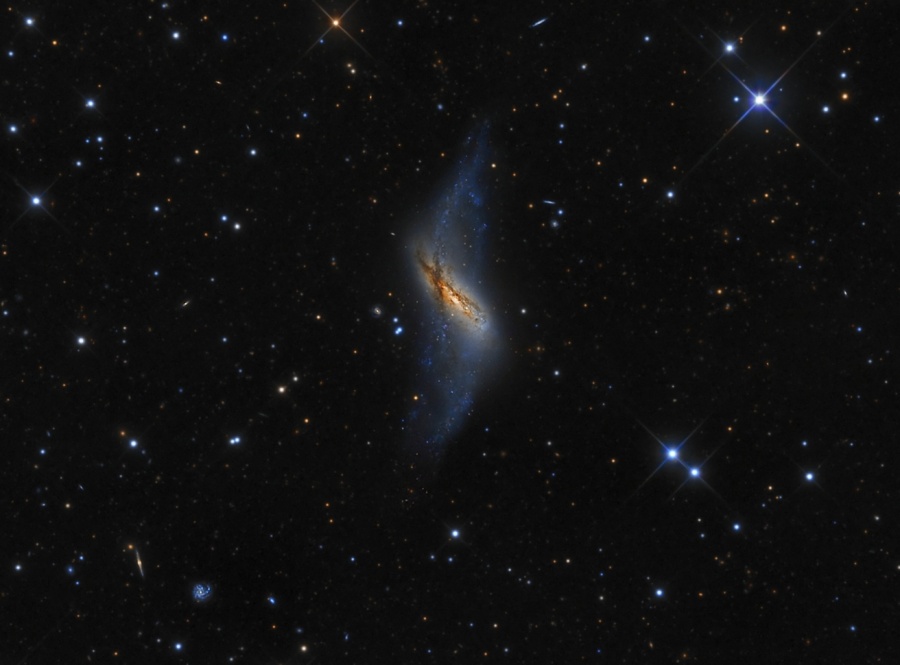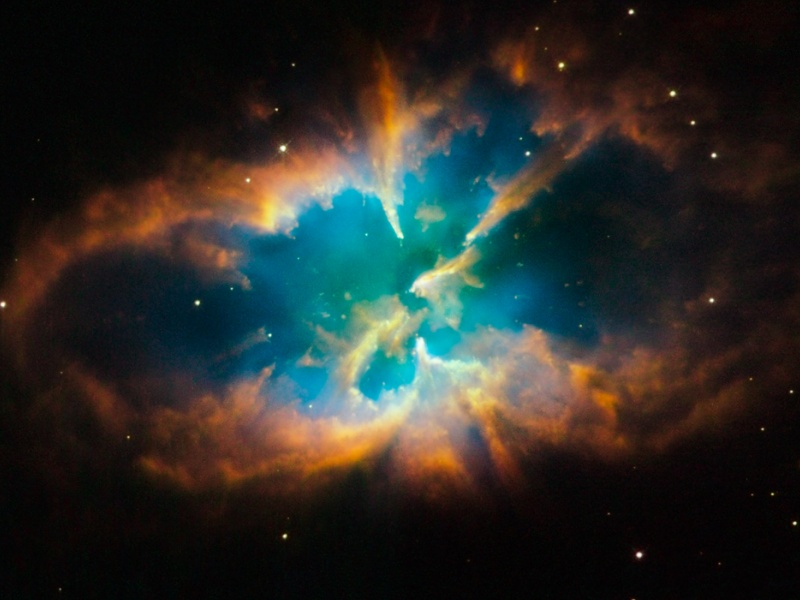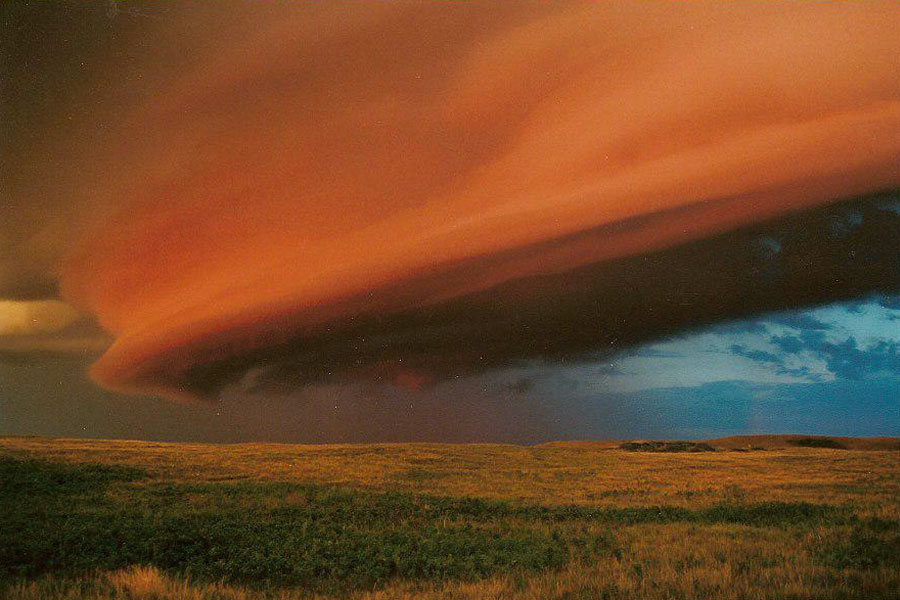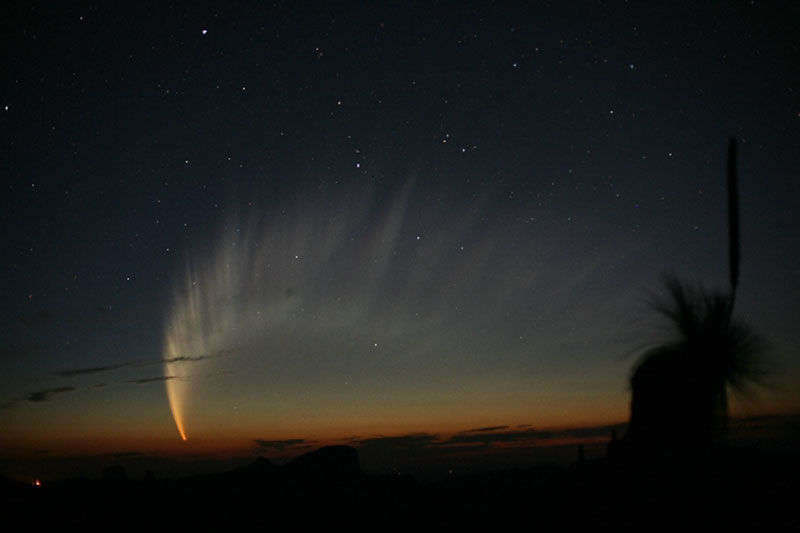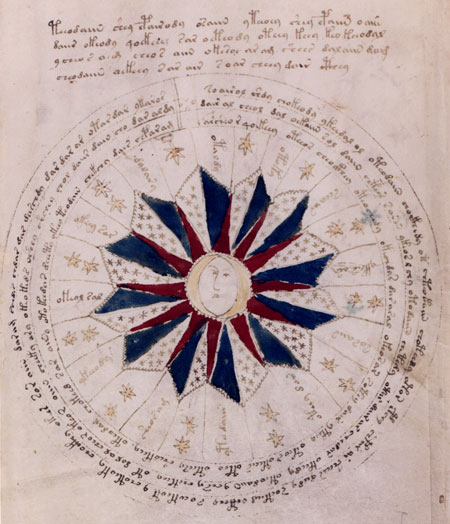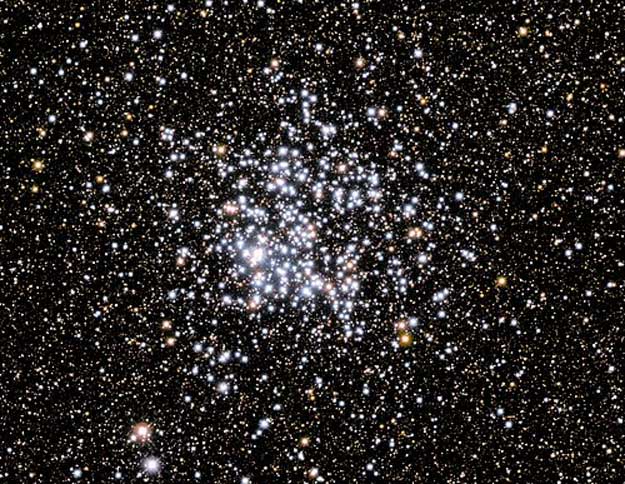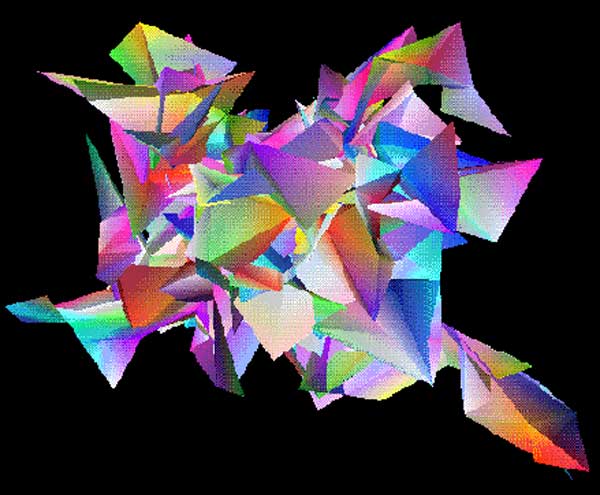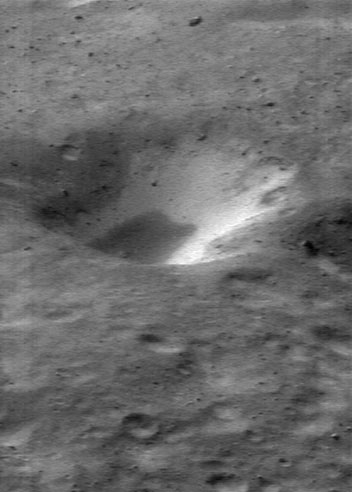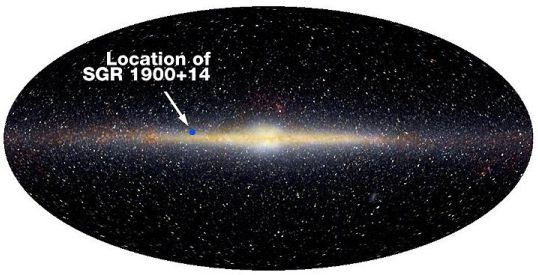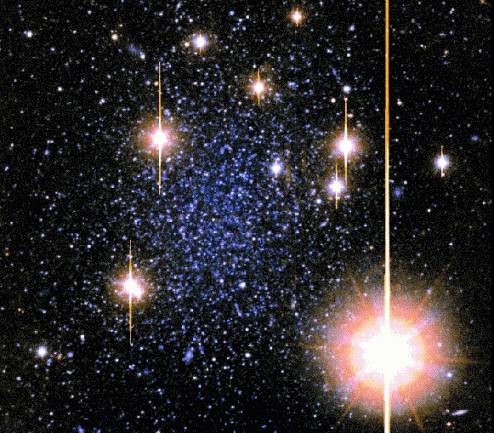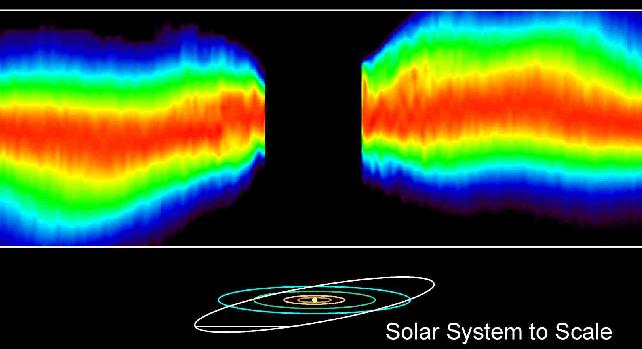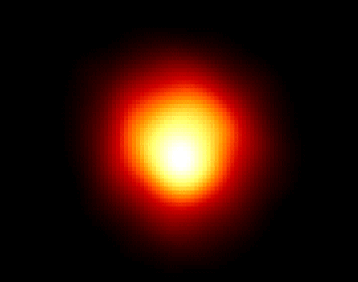| << Previous | Index | Next >> |
2015 Blasting skyward an Atlas V rocket carrying a U.S. Navy satellite pierces a cloud bank in this starry night scene captured on January 20. On its way to orbit from Space Launch Complex 41, Cape Canaveral Air Force Station, planet Earth, the rocket streaks past brightest star Sirius, as seen from a dark beach at Canaveral National Seashore. Above the alpha star of Canis Major, Orion the Hunter strikes a pose familiar to northern winter skygazers. Above Orion is the V-shaped Hyades star cluster, head of Taurus the Bull, and farther still above Taurus it's easy to spot the compact Pleiades star cluster. Of course near the top of the frame you'll find the greenish coma and long tail of Comet Lovejoy, astronomical darling of these January nights.
2014 Yes, but can your blizzard do this? In Upper Michigan's Storm of the Century in 1938, some snow drifts reached the level of utility poles. Nearly a meter of new and unexpected snow fell over two days in a storm that started 76 years ago tomorrow. As snow fell and gale-force winds piled snow to surreal heights; many roads became not only impassable but unplowable; people became stranded; cars, school buses and a train became mired; and even a dangerous fire raged. Fortunately only two people were killed, although some students were forced to spend several consecutive days at school. The above image was taken by a local resident soon after the storm. Although all of this snow eventually melted, repeated snow storms like this help build lasting glaciers in snowy regions of our planet Earth.
2013 The North America nebula on the sky can do what the North America continent on Earth cannot -- form stars. Specifically, in analogy to the Earth-confined continent, the bright part that appears as Central America and Mexico is actually a hot bed of gas, dust, and newly formed stars known as the Cygnus Wall. The above image shows the star forming wall lit and eroded by bright young stars, and partly hidden by the dark dust they have created. The part of the North America nebula (NGC 7000) shown spans about 15 light years and lies about 1,500 light years away toward the constellation of the Swan (Cygnus).
2012 Believe it or not, this is the North Pole of Saturn. It is unclear how an unusual hexagonal cloud system that surrounds Saturn's north pole was created, keeps its shape, or how long it will last. Originally discovered during the Voyager flybys of Saturn in the 1980s, nobody has ever seen anything like it elsewhere in the Solar System. Although its infrared glow was visible previously to the Cassini spacecraft now orbiting Saturn, in 2009 the mysterious hexagonal vortex became fully illuminated by sunlight for the first time during the Cassini's visit. Since then, Cassini has imaged the rotating hexagon in visible light enough times to create a time-lapse movie. The pole center was not well imaged and has been excluded. This movie shows many unexpected cloud motions, such as waves emanating from the corners of the hexagon. Planetary scientists are sure to continue to study this most unusual cloud formation for quite some time.
2011 NGC 660 lies near the center of this intriguing skyscape, swimming in the boundaries of the constellation Pisces. Over 20 million light-years away, its peculiar appearance marks it as a polar ring galaxy. A rare galaxy type, polar ring galaxies have a substantial population of stars, gas, and dust orbiting in rings nearly perpendicular to the plane of the galactic disk. The bizarre configuration could have been caused by the chance capture of material from a passing galaxy by the disk galaxy, with the captured debris strung out in a rotating ring. The polar ring component can be used to explore the shape of the galaxy's otherwise unseen dark matter halo by calculating the dark matter's gravitational influence on the rotation of the ring and disk. Broader than the disk, NGC 660's ring spans about 40,000 light-years.
2010 The Moon's shadow raced across planet Earth on January 15. Observers within the central shadow track were able to witness an annular solar eclipse as the Moon's apparent size was too small to completely cover the Sun. A visually dramatic ring of fire, the annular phase lasted up to 11 minutes and 8 seconds depending on location, the longest annular solar eclipse for the next 1,000 years. This picture of the Moon's silhouette just before mid-eclipse was taken within the eclipse path from the city of Kanyakumari at the southern tip of India. The telescopic image was made through a filter that blocks most visible light, but still transmits light from hydrogen atoms. As a result, detailed mottling, or granulation, caused by heat convection in the Sun's atmosphere can be seen around the dark lunar disk.
2009 NGC 2818 is a beautiful planetary nebula, the gaseous shroud of a dying sun-like star. It could well offer a glimpse of the future that awaits our own Sun after spending another 5 billion years or so steadily using up hydrogen at its core, and then finally helium, as fuel for nuclear fusion. Curiously, NGC 2818 seems to lie within an open star cluster, NGC 2818A, that is some 10,000 light-years distant toward the southern constellation Pyxis (the Compass). At the distance of the star cluster, the nebula would be about 4 light-years across. But accurate velocity measurements show that the nebula's own velocity is very different from the cluster's member stars. The result is strong evidence that NGC 2818 is only by chance found along the line of sight to the star cluster and so may not share the cluster's distance or age. The Hubble image is a composite of exposures through narrow-band filters, presenting emission from nitrogen, hydrogen, and oxygen atoms in the nebula as red, green, and blue hues.
2008 Perhaps it's time to go inside. Such thoughts might occur to people witnessing the approach of an impressive shelf cloud. Shelf clouds are typically seen leading thunderstorms, although they may precede any well defined front of relatively cold air. Shelf clouds differ from roll clouds because shelf clouds are attached to a larger cloud system lurking above. Similarly, shelf clouds differ from wall clouds because wall clouds typically trail storm systems. The above pictured shelf cloud was photographed toward the southwest during a trip crossing the prairies of Saskatchewan, Canada on the Trans-Canada Highway in 2001 August. A rising Sun illuminated the impressive cloud from the east as it advanced from the west.
2007 Comet McNaught, the Great Comet of 2007, has grown a long and filamentary tail. The spectacular tail spreads across the sky and is visible to Southern Hemisphere observers just after sunset. The head of the comet remains quite bright and easily visible to even city observers without any optical aide. The amazing tail is visible on long exposures and even to the unaided eye from a dark location. Reports even have the tail visible just above the horizon after sunset for many northern observers as well. Comet McNaught, estimated at magnitude -2 (minus two), was caught by the comet's discoverer in the above image just after sunset last Friday from Siding Spring Observatory in Australia. Comet McNaught, the brightest comet in decades, is now fading as it moves further into southern skies and away from the Sun and Earth.
2006 These bacteria could survive on another planet. In an Earth lab, Deinococcus radiodurans (D. rad) survive extreme levels of radiation, extreme temperatures, dehydration, and exposure to genotoxic chemicals. Amazingly, they even have the ability to repair their own DNA, usually with 48 hours. Known as an extremophile, bacteria such as D. rad are of interest to NASA partly because they might be adaptable to help human astronauts survive on other worlds. A recent map of D. rad's DNA might allow biologists to augment their survival skills with the ability to produce medicine, clean water, and oxygen. Already they have been genetically engineered to help clean up spills of toxic mercury. Likely one of the oldest surviving life forms, D. rad was discovered by accident in the 1950s when scientists investigating food preservation techniques could not easily kill it. Pictured above, Deinococcus radiodurans grow quietly in a dish.
2005 The ancient text has no known title, no known author, and is written in no known language: what does it say and why does it have many astronomy illustrations? The mysterious book was once bought by an emperor, forgotten on a library shelf, sold for thousands of dollars, and later donated to Yale. Possibly written in the 15th century, the over 200-page volume is known most recently as the Voynich Manuscript, after its (re-)discoverer in 1912. Pictured above is an illustration from the book that appears to be somehow related to the Sun. The book labels some patches of the sky with unfamiliar constellations. The inability of modern historians of astronomy to understand the origins of these constellations is perhaps dwarfed by the inability of modern code-breakers to understand the book's text. Can the eclectic brain trust of APOD readers make any progress? If you think you can provide any insight, instead of sending us email please participate in an online discussion. The book itself remains in Yale's rare book collection under catalog number "MS 408."
2004 After leaving its nest, the Spirit rover turned to capture this spectacular view over the Columbia Memorial Station and the floor of Gusev crater on the 16th sol of its visit to Mars. The sharp picture looks toward the northeast. Over 2 meters wide, the lander platform surrounded by deflated airbags, and the egress ramp used by the rover to complete its journey to the martian surface, are in the foreground. In the background lie Spirit's likely future waypoints and destination - initially toward a ridge on the left bordering an impact crater about 200 meters across and finally toward the hills visible on the horizon at the right. The crater is about 250 meters away while the hills are about 3 kilometers distant. Searching for evidence of ancient watery environments, Spirit's scientific instruments have begun to return data on the composition of the surface in the lander's vicinity, suggesting that iron-bearing volcanic minerals are present.
2003 Many stars like our Sun were formed in open clusters. The above pictured open cluster, M11, contains thousands of stars and is just over five thousand light years distant. The stars in this cluster all formed together about 250 million years ago. The bright young stars in M11 appear blue. Open clusters, also called galactic clusters, contain fewer and younger stars than globular clusters. Also unlike globular clusters, open clusters are generally confined to the plane of our Galaxy. M11 is visible with binoculars towards the constellation of Scutum.
2002 For the first time, Earth's gravity has been used to isolate quantum energy levels of the neutron. The effect may be used in the future to test for slightly different effects of gravity on neutrally charged particles of different mass. In an experiment by Valery Nesvizhevsky and colleagues at the Laue-Langevin Institute, carefully dropped neutrons were seen to appear at only discrete heights. The effect is also of interest because it involves the intersection of two branches of physics that remain formally separate. A theory known as Quantum Mechanics tells us about how the universe works on the smallest scales, while Einstein's General Theory of Relativity tells us about how gravity and the universe works on the largest scales. The effect does not in itself, however, imply attributes of a possible quantum field nature of gravity. Pictured above is a false-color surface that might be created by the evolution of a one-dimensional string. By describing fundamental particles as tiny strings, many physicists are working toward the creation of a truly quantum theory of gravity.
2001 What lies beneath the surface of asteroid Eros? This image taken two weeks ago by the robot NEAR spacecraft orbiting the dark asteroid shows a kilometer-wide crater where some type of light material lies beneath some of the darker surface regolith. This light substance, seen on other photographs, may be relatively fresh material not yet well exposed to a darkening solar wind and micrometeorite impacts. As fuel wanes, NASA plans to end the NEAR spacecraft mission on February 12 with a spectacular controlled descent to the asteroid's surface. Although not designed to survive a landing, it is hoped that NEAR will be able to record and relay high-resolution pictures on its way down.
2000 Indicated on this infrared image of the galactic center region is the position of SGR 1900+14 - the strongest known magnet in the galaxy. SGR 1900+14 is believed to be a city-sized, spinning, super-magnetic neutron star, or Magnetar. How strong is a Magnetar's magnetic field? The Earth's magnetic field which deflects compass needles is measured to be about 1 Gauss, the strongest fields sustainable in Earth-based laboratories are about 100,000 Gauss, yet the Magnetar's monster magnetic field is estimated to be 1,000,000,000,000,000 Gauss. A magnet this strong, located at about half the distance to the Moon would easily erase your credit cards and suck pens out of your pocket. In 1998, from a distance of about 20,000 light-years, SGR 1900+14 generated a powerful flash of gamma-rays detected by many spacecraft. That blast of high-energy radiation is now known to have had a measurable effect on Earth's ionosphere. At the surface of the Magnetar, its powerful magnetic field is thought to buckle and shift the neutron star crust generating the intense gamma-ray flares.
1999 The Pegasus dwarf spheroidal galaxy (Peg dSph) is a small, newly recognized member of the Local Group of Galaxies. Likely a satellite companion of the Local Group's dominant player, the large spiral Andromeda (M31), the Pegasus dwarf galaxy is almost hidden in the glare of relatively bright foreground stars in our own Milkyway. Still, this dramatic Keck telescope 3-color image reveals Peg dSph as a clump of fainter, bluer stars 2,000 or so light-years across. Excitement over discoveries of Peg dSph and other nearby dwarf galaxies reflects the fact that little galaxies may loom large in the process of galaxy evolution. They are thought to be the building blocks from which larger galaxies are constructed.
1998 What did our Solar System look like as the planets were forming? Since the 1980s, astronomers have been pointing toward Beta Pictoris, a young, sun-like star a mere 50 light-years distant, as a likely example. Beta Pic is surrounded by a disk of dust which we view nearly edge-on. The dust disk shines by reflected starlight and has been examined with ever increasing detail to search for signs of planetary formation. The trick is to follow the disk as close in to the star as possible, without being overwhelmed by the direct starlight. To make this Hubble Space Telescope image, a coronagraph was used to block the direct starlight and achieve the closest view yet. The false color picture shows the inner section of the dusty disk to within nearly 1.5 billion miles of the star itself, about the scale of the orbit of Uranus. The obvious warp is indirect evidence that a planet now orbits this young sun, slightly inclined to the disk. The planet's gravitational pull would produce the visible distortion.
1997 It's bigger than a bread box. In fact, it's much bigger than all bread boxes put together. Abell 2199 is huge. In fact, it is a close, large cluster of galaxies, containing several thousands of galaxies centered around a central dominant galaxy. "Close," however, is only relative to other clusters of galaxies, since light takes about 50 million years to reach us from A2199. All of the fuzzy objects in the above picture are galaxies, but these galaxies do not contain most of the matter in the cluster. By studying clusters like A2199, astronomers conclude that some form of dark matter dominates the motion of the bright galaxies. What, exactly, this dark matter is poses one of the greatest astronomical puzzles of modern times.
1996 Betelgeuse (sounds a lot like "beetle juice"), a red supergiant star about 600 lightyears distant, is shown here in this Hubble Space Telescope image which represents the first direct picture of the surface of a star other than the Sun. While Betelgeuse is cooler than the Sun, it is more massive and over 1000 times larger - if placed at the center of our Solar System, it would extend past the orbit of Jupiter. This image reveals a bright, as yet unexplained hotspot on its surface. Betelgeuse is also known as Alpha Orionis, one of the brightest stars in the familar constellation of Orion, the Hunter. Like many star names, Betelgeuse is Arabic in origin. It is derived from a phrase which refers to the hunter's shoulder or armpit, the general area occupied by this star in drawings of the figure in the constellation. As a massive red supergiant, it is nearing the end of its life and will soon become a supernova.
| << Previous | Index | Next >> |


